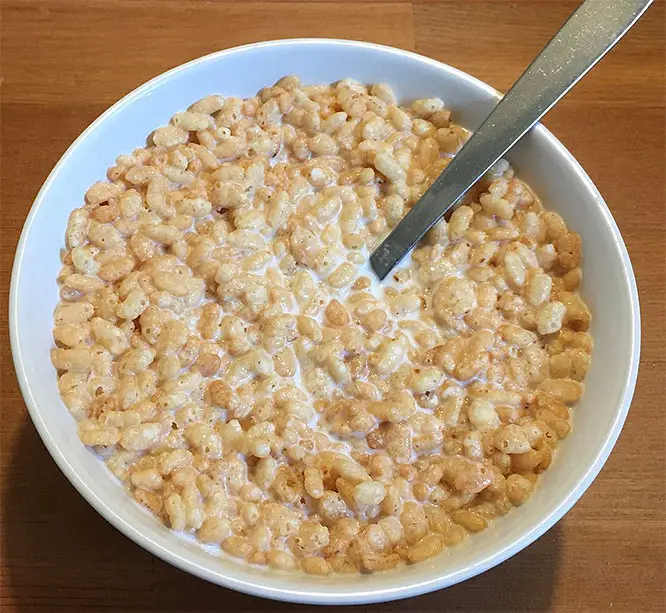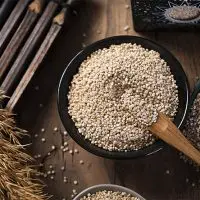When it comes to breakfast, few things are more beloved than a bowl of Rice Krispies. Kids and adults love the snap, crackle, and pop of this crunchy cereal in milk! But as delicious as they may be, there is some debate among nutritionists about whether or not Rice Krispies should really be considered a healthy meal option.
Here, we’ll explore all aspects of this tasty treat – from its ingredients to possible health benefits – so you can make your own informed decision about these iconic breakfast cereals. So if you’ve been wondering “are Rice Krispies healthy?”, keep reading for more information.

What are Rice Krispies made of?
Original Rice Krispies contain very simple ingredients: Rice, sugar, salt and barley malt extract. They also contain added vitamins and minerals including niacin, iron, B6, riboflavin, thiamin, folic acid, vitamin D and vitamin B12. These vitamins and minerals are a great addition to your diet, helping to support overall health and well-being.
So does this mean that Rice Krispies are good for you? Some nutritionists believe that the added sugar in these cereals makes them a less-than-ideal choice, especially when it comes to weight loss. While sugar adds sweetness and flavor to the cereal, it also provides very few nutrients – and can even contribute to weight gain if you eat too much of it.
Other people argue that Rice Krispies are an excellent source of carbohydrates and other nutrients, making them a healthy option for most people.
To see how healthy Rice Krispies really are, we need to look at the broader nutritional profile of these breakfast cereals.
Rice Krispies Nutritional Profile
A serving of 30g of original Rice Krispies provides:
- 116 calories
- 0.4g of fat (0.1g of saturated fat)
- 26g of carbohydrates
- 2.4g of added sugars
- 0.6g fibre
- 2.1g protein
- 0.3g salt
- 50% of your daily vitamin D needs
- 25% of your daily recommended intake of vitamins B1, B2, B3, B9 and vitamin B12.
- 17% of your daily iron needs
So overall, we can see that Rice Krispies are not necessarily unhealthy. The added sugars are a concern, but the high levels of important vitamins and minerals make them a good choice for those who lead an active lifestyle and have an overall healthy diet.
However, you have to keep in mind that not many people will stick to the recommended portion of 30g. Many people actually eat double the amount or even more so in the end, Rice Krispies can be quite high in calories and added sugars.
How many calories are in a bowl of Rice Krispies with full-fat milk?
A typical bowl of Rice Krispies with full-fat milk contains approximately 225 calories. This makes them a relatively calorie-dense breakfast option, so you may want to consider using lower-calorie milk alternatives like skim or almond milk if you are trying to lose weight or control your calorie intake.
However, considering that most people will eat more than just a single portion of Rice Krispies, it’s also important to keep in mind that these calories can add up quickly. So, a typical bowl of Rice Krispies with milk could contain over 400 calories if you eat more than one portion.
Are there any health benefits to eating Rice Krispies?
Yes, there are a number of potential health benefits to eating Rice Krispies, including:
- Boosting energy levels and providing a quick source of carbs for athletes or people who exercise regularly.
- Supporting brain health due to the high levels of B vitamins in these cereals.
- Providing a source of iron and other important minerals, which help to strengthen the immune system and support overall health.
However, it’s important to remember that no single food can provide all of the nutrients you need on a daily basis, so it’s best to eat Rice Krispies as part of a healthy, balanced diet.
So if you’re looking for a delicious breakfast cereal that can also provide some key nutrients, Rice Krispies are definitely worth considering. Just be mindful of your portion size, and try to avoid adding too much sugar or other unhealthy ingredients like butter or syrup. With a little bit of moderation and self-control, Rice Krispies can be a great addition to your diet.
Are Rice Krispies good for weight loss?
Rice Krispies can be part of a healthy weight loss plan, but only in moderation. When choosing cereal for weight loss, look for low-sugar options that contain whole grains and fiber.
Rice Krispies are unfortunately mostly malt and refined carbohydrates, which are not ideal sources of nutrition when trying to maintain a healthy weight.
Additionally, many milk alternatives have added sugars – something to consider if you’re looking to reduce your intake. To make Rice Krispies a healthier choice for those trying to lose weight, adding high-protein milk and fresh berries can add the necessary nutrients to make it an acceptable breakfast option.
Alternatives to Rice Krispies for a healthy breakfast
Some alternatives to Rice Krispies for a healthy breakfast include plain oatmeal, Greek yogurt with fresh fruit and nuts, granola with milk or unsweetened almond milk, and whole-grain toast with avocado and scrambled eggs. These options are all high in protein, complex carbohydrates, and healthy fats, making them ideal for those looking to lose weight.
FAQs about Kellogg’s Rice Krispies
Are Rice Krispies a good choice for athletes or people who exercise regularly?
Yes, Rice Krispies are a good choice for athletes or people who exercise regularly, as they provide an excellent source of carbs to fuel your workouts and give you the energy you need.
They are also low in fat and contain several key vitamins and minerals that support overall health, including iron, B vitamins, and vitamin D.
However, it’s important to remember that eating a balanced diet and getting regular exercise are the best ways to support your health, so Rice Krispies should be just one part of a healthy lifestyle.
Can Rice Krispies make you fat?
No, Rice Krispies cannot make you fat on their own. However, they are high in calories and may not be the best choice if you’re trying to lose weight or maintain a healthy weight.
If you want to avoid gaining excess weight from eating Rice Krispies, it’s important to practice portion control and stick to a healthy, balanced diet.
Additionally, you may want to opt for low-sugar milk alternatives or skip the added toppings like butter or syrup in favor of fresh fruit, nuts, seeds, or plain yogurt.
Are Kellogg’s Rice Krispies treats healthy?
Kellogg’s Rice Krispies treats are not necessarily healthy, as they are high in refined sugar and other unhealthy ingredients like butter or syrup. However, if you’re looking for an occasional treat, they may be a good choice as long as you practice portion control and make sure to include other healthy foods in your diet.
For a more nutritious alternative, you may want to try making your own Rice Krispies treats with a few simple ingredients like non-fat Greek yogurt, fresh berries, and a handful of nuts.
As with any food, the key to maintaining a healthy weight is moderation and an overall balanced diet. So if you’re looking for a delicious treat, Rice Krispies treats may be a good choice, but you should always make sure to get plenty of fruits, vegetables, lean proteins, and complex carbs from whole grains for the best overall nutrition.
Can babies eat Rice Krispies?
It is generally not recommended to give babies or young children Rice Krispies, as these products are high in refined sugars and low in other important nutrients like protein, fiber, vitamins, and minerals.
However, there may be some situations where a doctor recommends giving Rice Krispies to infants under the supervision of a healthcare professional. If you are considering giving your baby or young child Rice Krispies, it is best to consult with a paediatrician first and to make sure that you are also following the rest of an overall healthy diet.
Are Rice Krispies ok for toddlers?
Rice Krispies may be an option for toddlers, as long as they are part of a well-balanced and healthy diet. However, it’s important to remember that your toddler should still get the bulk of their calories and nutrients from other sources like fruits, vegetables, whole grains, lean proteins, and dairy.
So if you do decide to give your toddler Rice Krispies, it’s best to keep portions small and to combine them with other nutrient-rich foods whenever possible.
Additionally, it’s important to always check the ingredients list for any potential allergens or sensitivities and to talk to your toddler’s paediatrician about whether Rice Krispies are right for their individual diet and nutritional needs.
Ultimately, whether or not Rice Krispies are ok for toddlers depends on a variety of factors, including a child’s age, overall diet, and individual nutritional needs.
So if you are considering giving your toddler this popular cereal product, it’s best to consult with their paediatrician first to make sure that Rice Krispies are the right choice for them. If your child does tolerate Rice Krispies well, it’s also important to make sure that you are following the rest of a balanced and healthy diet, so that your child can get the best possible nutrition from all the different foods they are eating.
Rice Krispies or Weetabix: which is the better choice for a healthy breakfast?
When considering whether to eat Rice Krispies or Weetabix for breakfast, it’s important to take a number of factors into account, including the overall nutritional profile of each cereal, as well as your individual dietary needs and preferences.
On the whole, Rice Krispies are often considered to be a less healthy choice than Weetabix, as they tend to be higher in sugar and refined carbohydrates.
However, both cereals can be part of a balanced and healthy diet when eaten in moderation, so it’s ultimately up to you to decide which breakfast cereal is the best fit for your individual needs.
Conclusion: Are Rice Krispies good or bad for you?
While Rice Krispies may have some positive aspects, such as their convenient and familiar format, overall they are not a particularly healthy choice.
They are high in sugar and refined carbohydrates, which can lead to weight gain and other health issues. However, if you eat them in moderation as part of a balanced diet that includes plenty of fruits, vegetables, and other healthy carbohydrates, Rice Krispies can be a suitable option.
So if you’re looking for a convenient and tasty breakfast cereal, Rice Krispies may be a good choice, but it’s important to remember that there are many other healthier options available as well such as Weetabix, oatmeal, and yogurt.



